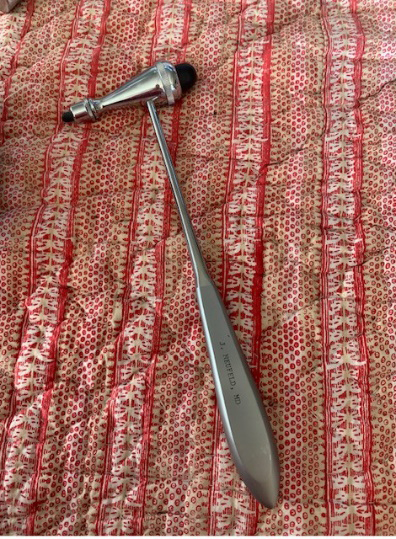Reflex Hammer
Last week, Dr. Jacob Neufeld’s widow gave me his reflex hammer which, much to my surprise, except for one detail, was identical to the one I lost at the UCSF Benioff CHO Rett Clinic just prior to the pandemic. This type of reflex hammer was highly encouraged at the time I did my residency in Physical Medicine and Rehabilitation at the Mayo Clinic. Difficult to find and I rarely encountered one outside of Mayo, it is expensive and of superb balance with precision accuracy. My favorite reflex hammer was replaced with the name of my late colleague engraved on it, making it even more special. The striking coincidence was that it unexpectedly arrived just weeks after the loss of another dear colleague, Dr. Mary Jones, the director of the same UCSF Benioff CHO Rett Clinic where my reflex hammer was lost several months prior.
Figure 1.
Dr. Jacob Neufeld’s reflex hammer.

On November 20
Dr. Mary was a peer reviewer of JPRM manuscripts and a supporter of the Journal. We were alike in many ways. She loved our video calls and the fact that we could continue to see our families virtually in their homes during the pandemic. We both did in-person home visits prior to the pandemic and attended IEPs, along with relentlessly advocating for our patients. Over a decade ago, Dr. Mary persistently approached me to become a member of the Rett Clinic and offered to treat me to my favorite restaurant in the SF Bay Area to discuss this opportunity. During this meeting, Mary said that she was even willing to change the clinic to a day and time that was most convenient for my schedule. This was an offer I could not refuse! As I had secretly longed to be a part of the Rett Clinic, I eagerly agreed to join.
To honor Dr. Mary and her international legacy in the Rett Community, we are featuring a Rehabilitation Rett review article in the first JPRM issue of 2021. Furthermore, there is a tribute to her from a Pediatric resident who, since childhood, knew Dr. Mary.
As you are likely aware, our esteemed colleague Dr. Jacob Neufeld, who died by suicide in September of 2017, founded JPRM in 2008. In January of 2018, I was appointed Editor-in-Chief (EIC). Since that time, one of my priorities has been to ensure that the members of our pediatric rehabilitation community know that JPRM is our journal and that its global reach continues to expand. It is abstracted/indexed in Academic Source Complete, CINAHL, Embase, Google Scholar, Index Medicus, MEDLINE, PubMed, Scopus, Ulrich’s Periodicals Directory and Web of Science.
In January of this year, I gave a virtual grand rounds presentation on physician moral injury, burnout and suicide to the UC Davis PM&R department. One attendee commented that it was important to remember that we have good and bad days. Suicide may be likened to a reflex hammer. Especially when bad events occur that can trigger a knee jerk reaction. There is literature that evaluates the impulsive knee jerk nature of suicide [1, 2, 3]. During those painful and provocative events [1], remember that there is help, the suicide prevention hotline, colleagues, family, and friends. Focusing on what has pulled us through before and knowing that even in those seemingly insurmountable moments that there will be times of joy and laughter again. As a specialty with a high rate of physician burnout [4] we are actively working towards vision zero, that is zero physician suicides.
Losing Dr. Jay, I now know firsthand about his struggles as EIC of the only pediatric rehabilitation journal in the world. The responsibility to assure JPRM’s integrity and how it is funded is all encompassing. In addition, EIC duties also include ensuring blinded peer review and communicating with the corresponding editors who often write asking why the editorial office has not yet responded to their manuscript submission. Recently, the journal formed a task force, whose members are the “angels on my shoulder”. I am deeply grateful for their support. Although many medical journals have funding supplemented by their academies and society dues, JPRM does not.
Therefore, I want to express my gratitude for all the support that has been provided to JPRM. I am delighted to say that there are dozens of people who have supported and assumed major roles in contributing to its growth and success.
For your convenience, please see the following hyperlinked URLs to access the featured content we published in the past 12 months. Access to the majority of the COVID-19 and spina bifida manuscripts are free. The 20 spina bifida guidelines are Open Access thanks to the Spina Bifida Association.
• Preprint 2021 Volume 14, Number 1: https://content.iospress.com/journals/journal-of-pediatric-rehabilitation-medicine/Preprint/Preprint.
• Spina Bifida Special Issue Volume 13, Number 4 https://content.iospress.com/journals/journal-of-pediatric-rehabilitation-medicine/13/.
• COVID Special Issue Volume 13, Number 3 https: //content.iospress.com/journals/journal-of-pediatric-rehabilitation-medicine/13/3.
• Cerebral Palsy Special Issue Volume 13, Number 2 https://content.iospress.com/journals/journal-of-pediatric-rehabilitation-medicine/13/.
• Varied Themed Issue Volume 13, Number 1 https://content.iospress.com/journals/journal-of-pedia tric-rehabilitation-medicine/13/1.
Funding will be necessary for our resident and fellows’ peer mentor and visual abstract publishing program. In addition, IOS Press will help by providing JPRM to all pediatric rehab residents and fellows at no cost. Please know that members of the Editorial Board also qualify to receive a free JPRM subscription. The subscription to the journal is about $100 a year for individuals and $500 a year for institutions.
JPRM editorial team is grateful to all who have donated through Foundation for PM&R and designated their contribution to JPRM’s programs. If you have not yet done so we are counting on each and every reader to go to http://foundationforpmr.org/support-the-journal-of-pediatric-rehabilitation-medicine/ and make a designated donation to JPRM’s editorial office. Through your funding we can provide faster manuscript processing, more efficient dissemination of pediatric rehabilitation literature and a dedicated statistician so that we can further reduce the time from submission to publication. We can also provide a robust resident and fellow program to assure the perpetuity of JPRM.
Please feel free to contact me if you have questions or comments: [email protected]; or Sara Tinsley our Managing Editor: [email protected].
Sincere wishes for a healthy and successful year
Elaine

Elaine L. Pico, MD, FAAP, FAAPM&R Editor-in-Chief, Journal of Pediatric Rehabilitation Medicine

Attending Physician, Pediatric Rehabilitation, UCSF Benioff Children’s Hospital Oakland
————————————————————————
References
[1] | Jordan JT, Samuelson KW, Tiet QQ. Impulsivity, Painful and Provacative Events, and Suicide Intent: Testing the Interpersonal Theory of Suicide. Suicide Life Threat Behav. (2019) Aug; 49: (4): 1187-1195. doi: 10.1111/sltb.12518. Epub 2018 Oct 11. |
[2] | McHugh CM, Chun Lee RS, Hermens DF, et al. Impulsivity in the self-harm and suicidal behavior of young people: A systematic review and meta-analysis. J Psychiatr Res. (2019) Sep; 116: : 51-60. doi: 10.1016/j.jpsychires.2019.05.012. Epub 2019 May 17. |
[3] | Liu RT, Trout ZM, Hernandez EM, et al. A behavioral and cognitive neuroscience perspective on impulsivity, suicide, and non-suicidal self-injury: Meta-analysis and recommendations for future research. Neurosci Biobehav Rev. (2017) Dec; 83: : 440-450. doi: 10.1016/j.neubiorev.2017.09.019. Epub 2017 Sep 18. |
[4] | Leslie Kane, MA 1/16/2019, Medscape Physician Burnout, Depression & Suicide Report 2019, http://bit.ly/MedscapePhysicianBurnout. |




